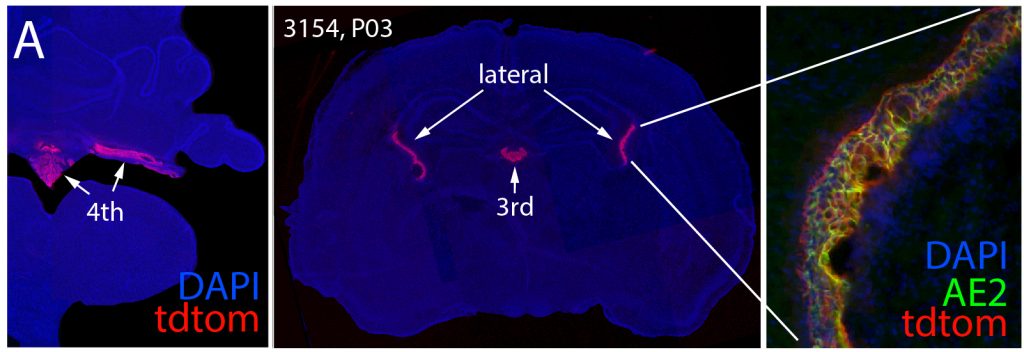Choroid Plexus Reporter Mice
Complementing the focus on human cells and tissues, the Monuki Lab continues to use mouse models for selected purposes. Recently, we developed transgenic lines using a human TTR bacterial artificial chromosome (BAC) to generate robust CPEC reporters (Johnson et al., 2019). TTR coding sequence and intervening introns were replaced with tdTomato or luciferase 2 cDNAs, leaving 5’ and 3’ untranslated regions of the human TTR gene intact. These lines faithfully recapitulate the spatial (CPECs, retinal pigment epithelium, pancreatic islets, and liver) and temporal specificity of TTR expression, with tdTomato expression onset in CPECs by E11.5. Unlike other CPEC reporters, tdTomato expression remained robust during adulthood and paralleled mouse Ttr levels in ChP and liver across the lifespan. TdTomato expression patterns were also consistent across founders, across generations, and between sexes, and two homozygous tdTomato lines were healthy and fertile. These reporter mice should prove useful for a variety of purposes, including CPEC isolations, CPEC tracking following transplantation, and CPEC identification in cultures or live mice. In addition, these reporters could provide insights into human TTR gene regulation, which has relevance to human physiology and disease, since TTR has been implicated in clearing β-amyloid peptides in AD, in neuronal heat shock responses and regeneration, and TTR amyloidoses. Cryopreserved sperm from these mice are available through the UCI Transgenic Mouse Facility.

Forebrain Patterning and Collaborations
In addition to our ChP-focused work, lab members are also involved in a variety of collaborations at and beyond UCI. Most of these collaborations involve studies of forebrain and cortical patterning and development, particularly in mouse models, as well as neuropathological studies in preclinical animal models of human stem cell transplantation.
